FLORENCE (FIRENZE)--DAY
2
Breakfast at the Annalena sucked. We had only one good breakfast, later
on, at the end of our trip. The Tuscans know nothing from bread and pastry.
They had corn flakes, lousy rolls, canned orange juice, packaged melba
toast.
We took a cab to the Synagogue
of Florence. We arrived shortly before 10, but they don't open until
10, and the woman inside was cold and uninviting. The building itself is
rather magnificent, designed in the 19th Century by Marcello's great-grandfather.
It looks a bit like the Blue Hill Avenue Shul.
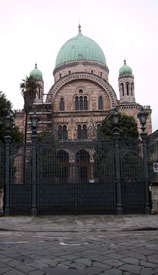
The Jews had been in Italy long before 1492, but with the Spanish Inquisition,
Sephardic Jews began to flock in. There was some trouble from Savanarola,
but for the most part, the Jews in Italy lived in safety and became quite
assimilated. Marcello, while he recognizes that he is Jewish, does not
place much stock in being Jewish, and sees himself as an Italian who happened
to have Jewish ancestors and had to suffer for it during the war. More
on that later. Inside, after the customary two-story climb to reach the
"first floor," there was a sanctuary, ornately guilded, bimah in the middle,
ladies in the balcony and not visible. The men have plaques at their places,
which are clearly assigned by status. Everyone here knows his place, and
wants it reserved for him, even though he never comes. They do have Shabbat
morning services. There is a museum of memorabilia of Italian Jewry. Our
guide was a young woman named Flavia Cavelli, not Jewish, but studying
Judaism at the univeristy.
And then we began to walk. We must have walked five miles each day.
God bless Neal, who advised us to get hiking boots. I got a pair of Vasque
boots from Sierra Trading Post,
with high tops and a thick cushioned sole with an inflexible nylon plate.
It was the first time in my life since I had polio at age 7 that I could
walk any distance without pain. Florence is quite flat, and everyone rides
a bike. It looks scary, but not much worse than Manhattan, where I have
biked many times at rush hour. Next time.
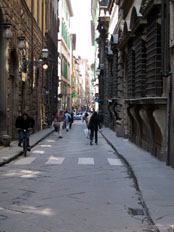
We passed the Duomo and Battisteria to end up at the Central Market,
a large warehouse building filled with meat markets and fruit and vegetable
dealers. It reminded me more of Cleveland than Fanueil Hall. Here, they
eat all parts of the animal: there were calves' heads, skinned, lined up
in a row, piles of hearts, kidneys, intestines, pancreas, brain, feet,
tails, legs, shoulders, ribs. There were cows, lambs, calves, sheep, rabbits,
quail, pheasant, chickens, pigs. We stopped in a nearby square for lunch
at the outdoor tables of Café Zaza, where we had a lovely lunch
of assorted crostini and cheeses, half a liter of red wine, and acqua
minerale frizzante.We walked past rows and rows of leather dealers--coats,
wallets, handbags--silk merchants--ties, scarfs, t-shirts--thousands of
booths, rather like the shuk in Jerusalem. We ended up in the Piazza
del Duomo,a breathtaking scene. On the one side is Il
Duomo,the great 15th Century cathedral of Florence, capped by the
hallmark of Florence, the dome designed by Brunelescchi. To stand under
it is staggering. The outside of the building is covered in ornate carvings
of unspeakable complexity. It's too much.
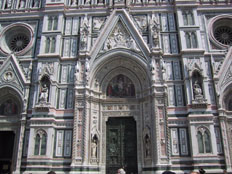 ..
..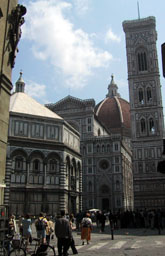
 ..
..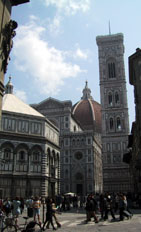 ..
..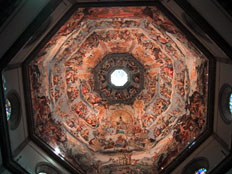
Across the plaza is the Battisteria,the
baptistry, whose doors were designed by Brunelescchi's rival, Ghiberti.
These doors, dubbed "The Gates of Paradise" by Michelangelo, consist of
twenty-eight gilded panels, each one depicting in bas-relief cartoon form,
a scene from the Bible. It's really something.
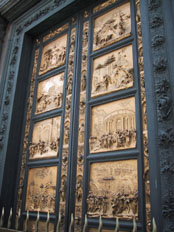 Battisteria
doors--Ghiberti..
Battisteria
doors--Ghiberti..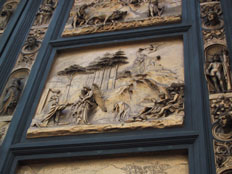 Binding
of Isaac
Binding
of Isaac
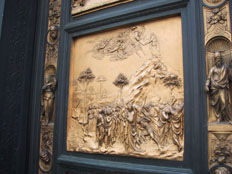 Moses..
Moses..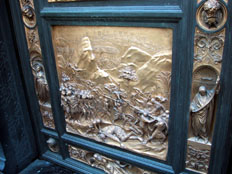 Life
of King David
Life
of King David
There is a psychiatric condition known as "Stendahl
Syndrome." In the 18th century, Stendahl visited Florence. Standing
in the piazza, he was overcome by the beauty and spirituality of the place,
and fell into a raving frenzy, what we would call today a brief reactive
psychosis. Eda Vidale, with whom we had lunch the following day, does research
on this syndrome. It mirrors the "Jerusalem Syndrome," which occurs in
a few pilgrims to the Holy City every year. Standing there in the piazza,
you can understand what it's about. But remember, it's spiritual, not religious.
This is a city of a thousand churches, but you never see a priest. The
churches are more art museums than they are houses of worship. Just as
Verdi wrote his Requiem, which is really just one more great opera, on
the commission of Manzoni, so the great artists of the Renaissance exercised
their magic at the commission of the Church or families like the Medicis.
Behind the Duomo is the Museo
del' Opera del' Duomo,a museum devoted to the construction of the
Duomo,as
well as of the Etruscan masterpieces that preceded it on that spot, dating
back to the 7th century. There were wonderful bas reliefs, one by Luca
Della Robbia of the Psalm "Praise the Lord with harp, and drum, and trumpets..."
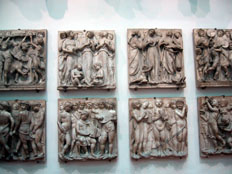 ..
..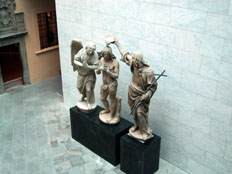
There was a stunning statue of La Maddalena--Mary Magadalene--by
Donatello from the 15th century. It captured the essence of anguished women
everywhere in every generation and looked as though it could have been
done in the 21st century.
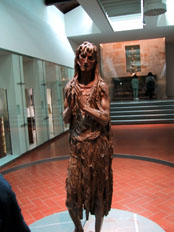
That evening, we went to the opera of the Maggio Musicaleat the
Teatro
Communale,for which I had secured tickets online. We were so excited
about going and so disappointed in so many ways. The opera house is realatively
new, probably built by Mussolini. It is sparse, lacking in taste and decor,
with no character whatsoever. The seats were very comfortable--separate
plush armchairs with lots of legroom. The opera was Verdi's Il
Trovatore,which is full of one luscious tune after the next. The
story line and libretto are absurd, but that's opera. I wonder what those
whose native tongue is Italian think when they here those banal lyrics.
Zubin Mehta conducted with flair and verve--he is a true Maestro. The voices
weren't bad, either, but they were miked!! Microphones in an Italian opera
house!! Gran Dio!! Roberto Alagna sang Manrico with style and power.
He was good looking, with long hair, tight leather pants, a white shirt,
and when he sang Di Quella Pira,concluding with the held high C,
chest out, sword extended into the air, women swooned and gay men...oops,
there are no gay men--this is Italy. It's clear why he is right up there
with the great Italian tenors of our day. Azucena was Larissa Diadkova.
Her mezzo voice piereced magnificently through the hall like a knife, but
those microphones...was it live, or was it Memorex? Fiorenza Cedolines
was an adequate Leonora, and a baritone named Carlo Guelfi (a very Florentine
name) was just stupendous as the Count de Luna. The chorus was massive--at
least a hundred people. So, when you have 60 men singing the "Anvil Chorus,"
boy, it's really something. The staging, the acting, the lighting, the
direction, the scenery--all were atrocious, done by the noted Pier Luigi
Pizzi. Your high school senior play was better. But it was Verdi, and it
was one show-stopping tune after the next, and some great ensemble singing.
We had the best seats, which cost $65 each, half the price of what they
would be at the Met, if you could get them.
Afterwards, we took a taxi home, speaking Italian all the way home with
the cabbie, who found us a tiny trattoria at 11:30 PM on the equivalent
of Thayer Street, with hundreds of young kids hanging out in the square.
The streets of Providence, and all of Tuscany and Umbria for that matter,
are safe. No one pinches your ass, and no one makes lewd remarks at women.
In short, it's not like Providence, at all.
On to Florence, Day 3
Back to previous page
Home


 ..
..
 ..
..
 Battisteria
doors--Ghiberti..
Battisteria
doors--Ghiberti.. Binding
of Isaac
Binding
of Isaac
 Moses..
Moses.. Life
of King David
Life
of King David
 ..
..
